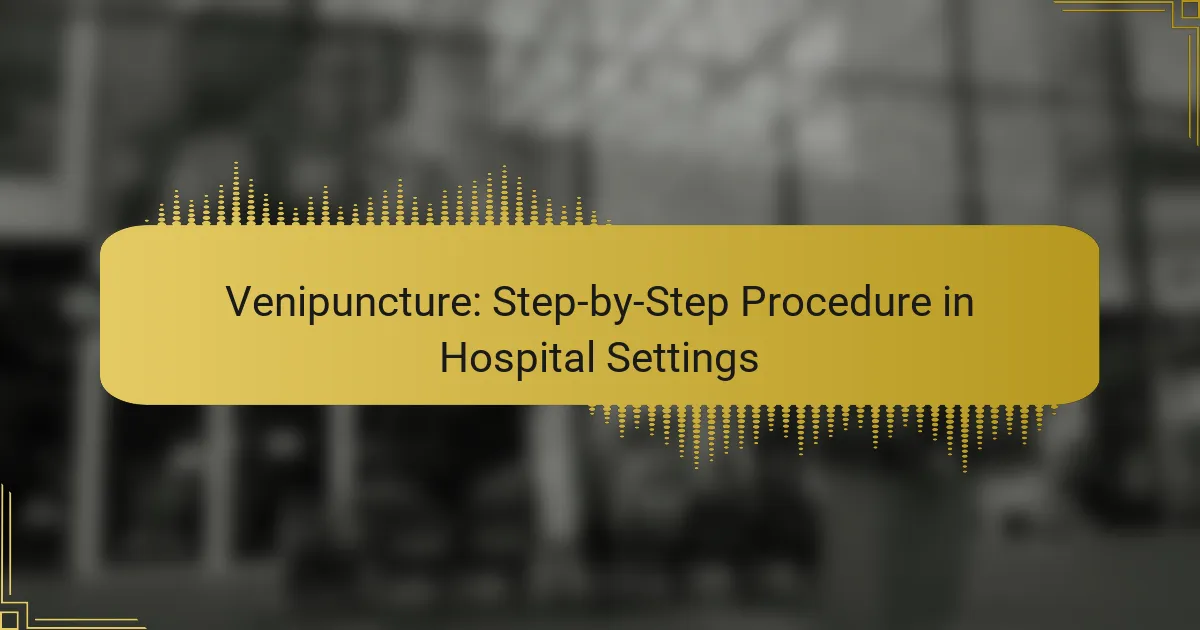Venipuncture is a critical medical procedure used to access veins for blood collection or medication administration. This technique involves careful preparation, site selection, and the use of specialized equipment to ensure both patient safety and comfort throughout the process.

What is the venipuncture procedure in hospitals?
Venipuncture is a medical procedure used to access a vein for various purposes, such as drawing blood or administering medications. It involves inserting a needle into a vein, typically in the arm, and requires proper technique to ensure patient safety and comfort.
Definition of venipuncture
Venipuncture refers to the process of puncturing a vein with a needle to collect blood or deliver intravenous therapy. This procedure is commonly performed by healthcare professionals, including nurses and phlebotomists, and is essential for diagnostic testing and treatment.
During venipuncture, the healthcare provider selects an appropriate vein, usually in the antecubital fossa, cleans the site, and uses a sterile needle to draw blood or administer fluids. Proper technique minimizes discomfort and the risk of complications.
Importance in medical settings
Venipuncture is crucial in medical environments as it facilitates essential diagnostic tests, such as blood counts and biochemical analyses. Accurate blood sampling is vital for diagnosing conditions, monitoring health status, and guiding treatment decisions.
Additionally, venipuncture allows for the administration of medications and fluids, which can be lifesaving in emergencies. The ability to efficiently perform this procedure is a key skill for healthcare providers in hospitals.
Common uses in patient care
Venipuncture is commonly used for several purposes in patient care, including routine blood tests, blood transfusions, and intravenous therapy. Routine tests may include complete blood counts (CBC) and metabolic panels, which help assess a patient’s overall health.
In emergency situations, venipuncture can be used to quickly administer life-saving medications or fluids. Understanding the indications for venipuncture and executing the procedure correctly is essential for optimal patient outcomes.

What are the steps of venipuncture?
Venipuncture involves several key steps to safely and effectively collect blood samples from a patient. These steps include preparing the patient, selecting the appropriate site, gathering necessary equipment, performing the procedure, and providing post-procedure care.
Preparation of the patient
Preparing the patient is crucial for a successful venipuncture. Begin by explaining the procedure to the patient, addressing any concerns they may have, and ensuring their comfort. Position the patient appropriately, usually sitting or lying down, to minimize the risk of fainting.
Additionally, confirm the patient’s identity and verify the test requirements. This helps prevent errors and ensures that the correct samples are collected for the right tests.
Selection of the venipuncture site
Selecting the right venipuncture site is essential for a smooth procedure. Common sites include the median cubital vein in the antecubital fossa, as it is typically the largest and most accessible vein. Other options may include the cephalic and basilic veins, depending on the patient’s anatomy.
Consider factors such as the patient’s age, hydration status, and any previous venipuncture history. Avoid sites with visible signs of infection, scarring, or previous punctures to reduce complications.
Gathering necessary equipment
Before performing venipuncture, gather all necessary equipment to ensure efficiency and minimize the risk of contamination. Essential items include gloves, alcohol swabs, a tourniquet, needles of appropriate gauge, collection tubes, and gauze.
Organize the equipment in a clean area to facilitate a smooth workflow. Ensure that all items are sterile and within their expiration dates to maintain safety standards.
Performing the venipuncture
To perform the venipuncture, first apply the tourniquet about 3-4 inches above the selected site to engorge the vein. Clean the area with an alcohol swab and allow it to dry to prevent stinging. Insert the needle at a 15-30 degree angle, bevel up, and advance it gently until you feel a “pop” indicating entry into the vein.
Once blood flow is established, connect the collection tube and allow it to fill to the required volume. After collecting the sample, remove the needle swiftly and apply pressure with gauze to minimize bleeding.
Post-procedure care
Post-procedure care is vital for patient safety and comfort. After removing the needle, apply pressure to the site for a few minutes to prevent hematoma formation. Once bleeding has stopped, apply a bandage to protect the site.
Instruct the patient to keep the bandage on for several hours and to avoid heavy lifting or strenuous activities with that arm for the rest of the day. Monitor the patient for any signs of complications, such as excessive bleeding or swelling, and provide appropriate follow-up instructions if necessary.

What equipment is needed for venipuncture?
Venipuncture requires specific equipment to ensure a safe and effective procedure. Essential items include needles, collection tubes, and safety devices to minimize risks during blood draws.
Types of needles used
Various types of needles are utilized in venipuncture, primarily ranging from 18 to 23 gauge. A larger gauge number indicates a smaller needle diameter; for instance, a 23-gauge needle is thinner than an 18-gauge needle. The choice of needle depends on the patient’s vein size and the volume of blood needed.
For pediatric patients or those with small veins, a butterfly needle may be preferred due to its smaller size and ease of use. In contrast, larger needles are generally used for blood donation or when a significant volume is required.
Vacutainer systems
Vacutainer systems are widely used for blood collection, consisting of a vacuum-sealed tube and a holder. These systems allow for quick and efficient blood draws, minimizing exposure to blood and reducing the risk of contamination. The vacuum in the tube helps draw blood into the collection container automatically.
Different colored tops on the tubes indicate the type of additive within, which is crucial for various tests. For example, a red-top tube is typically used for serum tests, while a lavender-top tube is used for complete blood counts.
Safety devices
Safety devices are critical in venipuncture to protect healthcare workers and patients from needlestick injuries. Many modern needles and blood collection systems come equipped with safety features, such as retractable needles or shields that cover the needle after use.
It is essential to follow proper disposal protocols for used needles and sharps. Always place used equipment in designated sharps containers to prevent accidental injuries and ensure compliance with health regulations.

What are the best practices for venipuncture?
Best practices for venipuncture include adhering to strict infection control protocols, ensuring patient comfort, and maintaining accurate documentation. These practices help minimize complications and enhance the overall experience for both patients and healthcare providers.
Infection control measures
Infection control is crucial during venipuncture to prevent healthcare-associated infections. Always wash hands thoroughly and use gloves to create a barrier between the healthcare provider and the patient. Additionally, disinfect the puncture site with an appropriate antiseptic, such as 70% isopropyl alcohol, before inserting the needle.
Utilizing single-use, sterile equipment is essential. Dispose of needles and other sharps in designated containers immediately after use to avoid accidental injuries and contamination.
Patient comfort techniques
Ensuring patient comfort during venipuncture can reduce anxiety and improve cooperation. Explain the procedure clearly to the patient, addressing any concerns they may have. Position the patient comfortably, and consider using a warm compress on the site prior to the procedure to dilate veins.
Distraction techniques, such as engaging the patient in conversation or providing a stress ball, can also help ease discomfort. Always monitor the patient’s reactions and adjust your approach as needed.
Documentation requirements
Accurate documentation is vital for effective communication and patient safety. Record the date and time of the venipuncture, the site used, and the type of specimen collected. Note any complications or patient reactions during the procedure.
Ensure that the patient’s identification is verified before proceeding and document the name of the healthcare provider performing the venipuncture. This information is essential for maintaining accountability and continuity of care.

What are the complications associated with venipuncture?
Complications from venipuncture can range from minor to serious, affecting both patient comfort and procedural success. Common issues include hematoma formation, phlebitis, and infection, which can arise from improper technique or equipment handling.
Common complications
Hematoma is one of the most frequent complications, occurring when blood leaks into the surrounding tissue, leading to swelling and discoloration. Phlebitis, or inflammation of the vein, can develop due to irritation from the needle or catheter, causing pain and redness. Infection at the puncture site is another risk, particularly if sterile techniques are not strictly followed.
Other complications may include nerve injury, which can result in tingling or numbness, and arterial puncture, where the needle inadvertently enters an artery instead of a vein. These complications can lead to more severe outcomes if not identified and managed promptly.
How to manage complications
To manage hematomas, apply direct pressure to the site and elevate the limb to reduce swelling. Cold compresses can also help alleviate discomfort. For phlebitis, warm compresses may be applied, and the affected vein should be monitored for signs of worsening inflammation.
In cases of infection, it is crucial to clean the area thoroughly and, if necessary, consult a healthcare provider for potential antibiotic treatment. If nerve injury or arterial puncture occurs, immediate medical evaluation is essential to prevent long-term damage. Always adhere to proper venipuncture protocols to minimize these risks.

What training is required for venipuncture in Canada?
In Canada, training for venipuncture typically involves a combination of formal education and practical experience. Healthcare professionals, such as nurses and phlebotomists, usually undergo specific training programs that cover anatomy, techniques, and safety protocols.
Educational requirements
To perform venipuncture, individuals generally need to complete a healthcare-related program, such as nursing or medical laboratory technology. These programs often include coursework in anatomy, physiology, and patient care, along with hands-on training in venipuncture techniques.
Certification and licensing
While certification is not universally required, many employers prefer candidates who have completed a recognized certification program in phlebotomy or a related field. In some provinces, specific licensing may be necessary, so it’s essential to check local regulations.
Practical training
Practical training is crucial for mastering venipuncture. This typically involves supervised practice in a clinical setting, where trainees learn to identify veins, use appropriate equipment, and manage patient comfort. Shadowing experienced professionals can also enhance skills and confidence.
